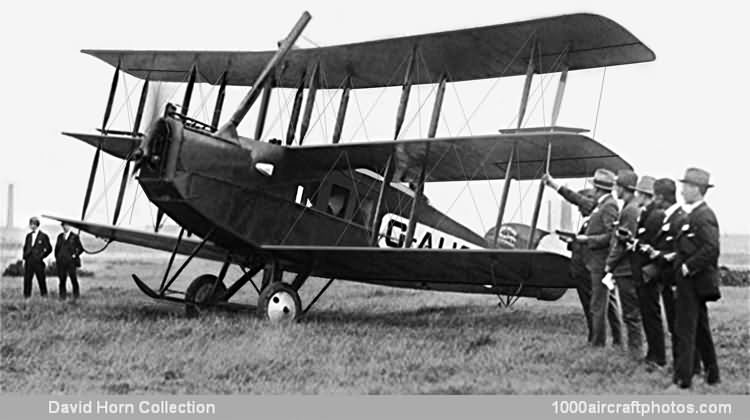09/30/2012. Remarks by Johan Visschedijk: "The Avro 547 G-EAQX was a commercial triplane with enclosed cabin built in February 1920 and powered by a 160 hp Beardmore liquid-cooled engine. Engine mountings and cabin structure were of new design but almost all the remainder of the Avro 547 was built from surplus Avro 504K components.
By reverting to A.V. Roe's favorite triplane formula, the span was kept to a minimum while construction was speeded and costs kept low by the ingenious use of standard 504K mainplanes, interplane struts, tail unit and landing gear. Ailerons were fitted to all three wings, the center pair being fitted with 'park bench' type aerodynamic balances. The tail unit employed the dorsal fin used on the Avro 504L and 536 and the landing gear was standard apart from a longer axle and a wider rear V-strut.
The fabric covered rear fuselage, although of generous proportions and quite unlike that of a 504K, was built in the same manner from spruce strip and used all the 504K metal fittings. Aluminum engine cowlings were used and the fuselage from nose radiator to the rear of the cabin was plywood covered. Fuel and oil tanks were located in a special bay behind the engine and the cabin accommodated four passengers in facing pairs in adjustable, spring mounted bucket seats.
With the seats removed, 113 cu.ft (3.20 cu.m) of space was available for the carriage of light freight or mail. An entry door, complete with railway carriage-type, strap operated, opening Triplex window, was on the starboard side. Immediately behind the cabin lay the pilot's open cockpit, offset to port to give adequate forward and downward view, and about two feet of the port center wing and starboard bottom wing trailing edges were cut back to the rear spar further to improve the view with the tail down.
Captain H. A. Hamersley flew the machine at Hamble Aerodrome, near Southampton, Hampshire and reported that performance and handling characteristics were much the same as those of the 504K. The airframe was already stressed for engines of higher power, so that when the rules of the Air Ministry Small Commercial Aeroplane Competition were published, it was a simple matter to build a second triplane in June 1920 and fit a 240 hp Siddeley Puma.
With this engine the calculated performance made it a likely winner and the machine consequently occupied a place of honor on the Avro stand at the Olympia Aero Show in London, July 9-20, 1920. With the competition in mind, several improvements were made in the cabin, notably 7 in (0.18 m) of leg room, hot and cold air control, interior lighting, upholstered bench type seats and a trapdoor for communicating with the pilot.
Registered G-EAUJ under the designation Avro 547A, the machine was flown from Hamble to Martlesham by Captain H.A. Hamersley and weighed in on August 3 to compete against the Austin Kestrel, Beardmore W.B.X, Bristol Seely Puma, Sopwith Wallaby and the Westland Limousine III (eventual winner of the Competition). Hamersley was the first competitor to start the tests when he made the glide test from 500 ft (152 m) next morning and covered the measured mile (1.61 km) at 95.7 mph (154 kmh).
Then followed reliability-with-economy, getting off and landing tests at an all-up weight of 3,683 lb (1,671 kg), a slow run at 51.5 mph (82.9 kmh) on August 12 and a measured landing run of 239 yards (219 m) on the 14th. The machine failed to qualify for an award because it was not inherently stable and had failed to reach the stipulated minimum top speed of 100 mph (161 kmh). In the landing trial the Avro 547A was put down rather hard and an landing gear strut was so badly bent that a quarter of an hour later the entire landing gear collapsed as it stood at dispersal.
After repairs it was flown back to Hamble but returned to Martlesham for official trials on October 12. It was flown on this occasion by H.J. Hinkler who stopped for three days of demonstration flights at Croydon en route. The return trip on October 30 followed the same pattern, after which it was based at Hamble until dismantled sometime after its final CofA renewal in August 1921.
At the invitation of S. Instone and Co. Ltd., H.J. Hinkler ferried the first machine, G-EAQX, to Croydon on June 1, 1920 where it was flown next day by Instone's chief pilot F.L. Barnard. He did not recommend its purchase and further demonstrations at Croydon on June 24 were equally abortive. A third 547 fuselage, built against the possible order, hung from the roof of the flight shed at Hamble until well into 1925 as mute reminder of these failures.
Nevertheless Queensland and Northern Territories Aerial Services Ltd. (Qantas) purchased G-EAQX in November 1920 for the Charleville-Katherine section of its proposed Melbourne-Darwin route, and a twice weekly service between Charleville and Cloncurry. The aircraft was crated and shipped to the Australian Aircraft and Engineering Co. Ltd., the Avro agents, and on arrival in March 1921 was assembled at Mascot. Here the slender main landing gear legs were replaced by stout, rubber-sprung V-struts more suited to unprepared landing grounds in Queensland.
In this form, and reregistered G-AUCR, the 547 was flown into second place in the Australian Aerial Derby at Victoria Park Racecourse, Sydney by Qantas manager Hudson Fysh on May 6, 1921 at an average speed of 69,5 mph (111.8 kmh). Soon afterwards the landing gear collapsed while P. J. McGinniss (co-founder of Qantas) was giving flights at Mascot prior to his departure for Queensland and the aircraft was then declared unsuitable for commercial flying and dismantled for spares."
